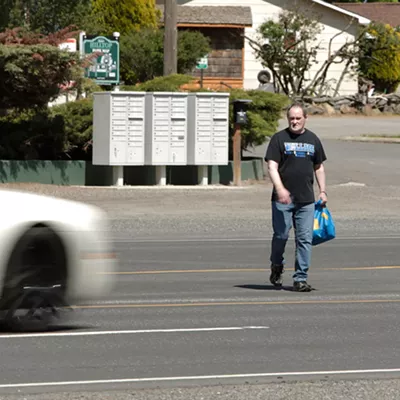With backstage space limited at so many theaters, a surprising proportion of the set elements and props (the elephant graveyard, the various parts of the wildebeest stampede, etc.) are stored up high in the wings and only brought down by motorized cranes and pulleys when needed.
The deck, which is eight inches deep, is fitted with all sorts of grooves and gizmos to allow for such effects as the swirling rise of Pride Rock, along with assorted pools of water, mole holes, geysers and cacti.
From a stagehand's point of view, the most demanding sequence in the show is the quick transition from the elephant graveyard to the wildebeest stampede.
"It takes about 20 people to do that," says Head Carpenter Mike Nye. "We rehearse that particular [transition] with the local crew for about an hour, an hour and a half. During the show, they're doing shadow puppets in there, and there's usually not a lot of room, so as we're moving the big set pieces off, we're stepping right over [the puppeteers]."
During an actual performance, there are seven dressers, seven carpenters, eight electricians, 18 stagehands and 38 singers and dancers scurrying around backstage -- so you can see the need for careful choreography. "We have five infrared cameras so we can monitor the backstage action and make sure that everyone is safe," says Nye.
As for the big set pieces, "they're all automated," says Nye. "There are tracks in the flooring, and it's all done by computer. They can also be moved offstage manually, if we have to."
Well, not completely automated. For reasons of staying compact and within the confines of a touring show -- the same reasons that reduce Pride Rock's dimensions slightly to 21 feet long by 8 feet high -- only half of the giant bones in the elephants' graveyard set are automated; the other half of the boneyard has to be moved onstage the old-fashioned way, using stagehands' muscles.
To create the optical illusion of hundreds of wildebeests galloping right into audience members' laps, Nye explains, the production uses two giant rollers, "like giant belt sanders, 10 feet tall and 14 feet wide," with animals that appear to be charging downhill painted on the rollers.
"They're computerized, but yeah," he adds, "they can be run manually."
Then larger wildebeest sculptures, on huge revolving contraptions, are slid into place. They're heavy but still have to be flown down from the rafters just in time to be positioned onstage. During all the onstage action, the sound of the chains and pulleys isn't noticeable, says Nye -- "but we still put dampers on them to muffle the sound."
Finally, actors wearing wildebeest costumes take their place in front, running in place at the head of the stampede.
That's when you're supposed to faint.
















